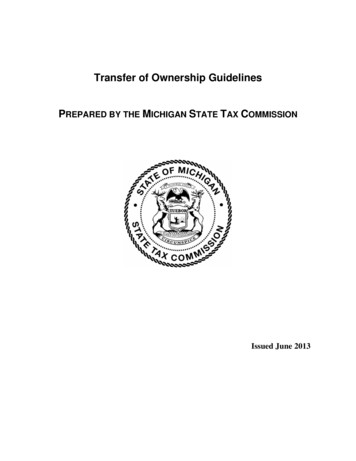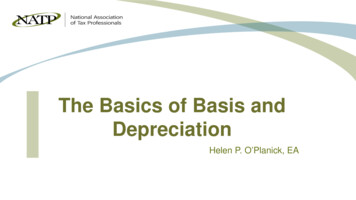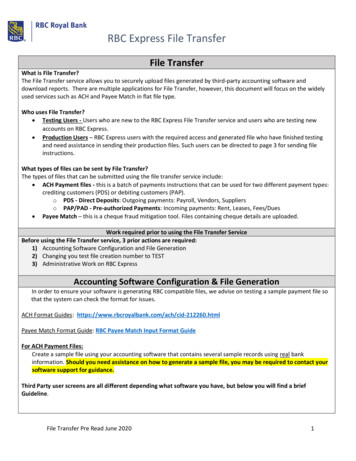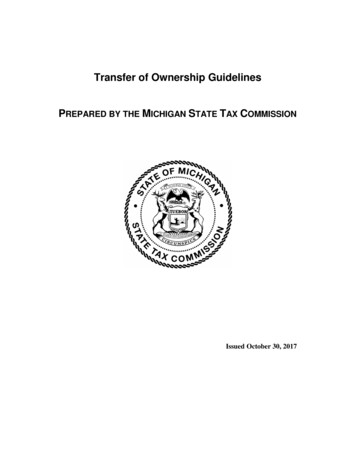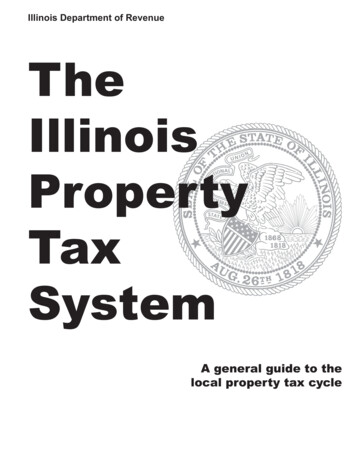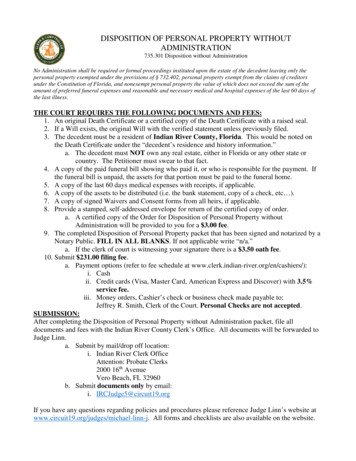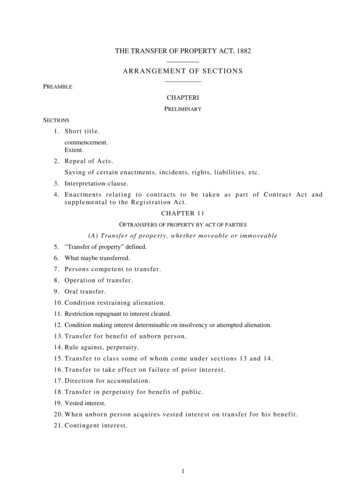
Transcription
THE TRANSFER OF PROPERTY ACT, 1882A R R A N G E M E N T O F S E C T IO N SPREAMBLECHAPTERIPRELIMINARYSECTIONS1. Shor t t it l e.commencement.Extent.2. Repeal of Acts.Saving of certain enactments, incidents, rights, liabilities, etc.3. Interpretation-clause.4. Enact ment s r el at i ng t o cont r act s t o be t aken as par t of Cont ract Act ands uppl ement al t o t he Regi s t r at i on Act .CHAPTER 11OFTRANSFERS OF PROPERTY BY ACT OF PARTIES(A) Transfer of pr oper ty, whether moveable or immoveable5. “Transfer of property” defined.6. What maybe transferred.7. Persons competent to transfer.8. Operation of transfer.9. Oral transfer.10. Condition restraining alienation.11. Restriction repugnant to interest cleated.12. Condition making interest determinable on insolvency or attempted alienation.13. Transfer for benefit of unborn person.14. Rule against, perpetuity.15. T r ansf er t o cl as s s ome of who m co me unde r s ect i ons 13 and 14.16. Transfer to take effect on failure of prior int erest.17. Direction for accumulation.18. Transfer in perpetuity for benefit of public.19. Vested interest.20. W hen unbor n pers on acquir es vest ed i nterest on trans fer f or his benef it.21. Contingent interest.1
SECTIONS22. Transfer to members of a class who attain a particular age.23. Transfer contingent on happening of specified uncertain event.24. Transfer to such of certain persons as survive at some period not specified.25. Conditional transfer.26. Fulfilment of condition precedent.27. Conditional transfer to one person coupled with transfer to another on failure of priordisposition.28. Ulterior transfer conditional on happening or not happening of specified event.29. Fulfilment of condition subsequent.30. Prior disposition not affected by invalidity of ulterior disposition.31. Condition that transfer shall cease to have effect in case specified uncertain eventhappens or does not happen.32. Such condition must not be invalid.33. Transfer conditional on performance of act, no time being specified for performance.34. Transfer conditional on performance of act, time being specified.Election35. Election when necessary.Apportionment36. Apportionment of periodical payments on determination of interest of person entitled.37. Apportionment of benefit of obligation on severance.(B) Transfer of immoveable property38. Transfer by person authorised only under certain circumstances to transfer.39. Transfer where third person is entitled to maintenance.40. Burden of obligation imposing restriction on use of land, or of obligation annexed toownership but not amounting to interest or easement.41. Transfer by ostensible owner.42. Transfer by person having authority to revoke former transfer.43. Transfer by unauthorised person who subsequently acquires interest in propertytransferred.44. Transfer by one co-owner.45. Joint transfer for consideration.46. Transfer for consideration by persons having distinct interests.47. Transfer by co-owners of share in common property.48. Priority of rights created by transfer.49. Transferee's right under policy.50. Rent bona fide paid to holder under defective title.2
SECTIONS51. Improvements made by bona fide holders under defective titles.52. Transfer of property pending suit relating thereto.53. Fraudulent transfer.53A. Part performance.CHAPTER IIIOF SALES OF IMMOVEABLE PROPERTY54. “Sale” defined.Sale how made.Contract for sale.55. Rights and liabilities of buyer and seller.56. Marshalling by subsequent purchaser.Discharge of incumbrances on sale57. Provision by Court for incumbranccs, and sale freed therefrom.CHAPTER IVOF MORTGAGES OF IMMOVEABLE PROPERTY AND CHARGES58. “Mortgage”, mortgage-money”and“mortgage-Simple mortgage.Mortgage by conditional sale.Usufructuary mortgage.English mortgage.Mortgage by deposit of title-deeds.Anomalous mortgage.59. Mortgage when to be by assurance.59A. References to mortgagors and mortgagees to include persons deriving title fromthem.Rights and liabilities of mortgagor60. Right of mortgagor to redeem.Redemption of portion of mortgaged property.60A.Obligation to transfer to third party instead of re-transference to mortgagor.60B. Right to inspection and production of documents.61. Right to redeem separately or simultaneously.62. Right of usufructuary mortgagor to recover possession.63. Accession to mortgaged property.Accession acquired in virtue of transferred ownership.3
SECTIONS63A. Improvements to mortgaged property.64. Renewal of mortgaged lease.65. Implied contracts by mortgagor.65A. Mortgagor’s power to lease.66. Waste by mortgagor in possession.Rights and liabilities of Mortgagee67. Right to foreclosure or sale.67A. Mortgagee when bound to bring one suit on several mortgages.68. Right to sue for mortgage-money.69. Power of sale when valid.69A. Appointment of receiver.70. Accession to mortgaged property.71. Renewal of mortgaged lease.72. Rights of mortgagee in possession.73. Right to proceeds of revenue sale or compensation on acquisition.74. [Repealed.].75. [Repealed.].76. Liabilities of mortgagee in possession.Loss occasioned by his default.77. Receipts in lieu of interests.Priority78. Postponement of prior mortgagee.79. Mortgage to secure uncertain amount when maximum is expressed.80. [Repealed.].Marshalling and contribution81. Marshalling securities.82. Contribution to mortgage-debt.Deposit in Court83. Power to deposit in Court money due on mortgage.Right to money deposited by mortgagor.84. Cessation of interest.Suits for foreclosure, sale or redemption85. [Repealed.].Foreclosure and sale86. [Repealed.].87. [Repealed.].88. [Repealed.].4
SECTIONS89. [Repealed.].90. [Repealed.].Redemption91. Persons who may sue for redemption.92. Subrogation.93. Prohibition of tacking .94. Right ofmesne mortgagee.95. Right of redeeming co-mortgagor to expenses.96. Mortgage by deposit of title-deeds.97. [Repealed.].Anomalous mortgages98. Rights and liabilities of parties to anomalous mortgages.Attachment of mortgaged property99. [Repealed.].Charges100. Charges.101. No merger in case of subsequent encumbrance.Notice and tender102. Service or tender on or to agent.103. Notice, etc., to or by person incompetent to contract.104. Power to make rules.CHAPTER VO F LEASES OF IMMOVEABLE PROPERTY105. Lease defined.Lessor, lessee, premium and rent defined.106.107.108.109.110.Duration of certain leases in absence of written contract orlocal usage.leases how made.Rights and liabilities of lessor and lessee.Rights of lessor’s transferee.Exclusion of day on which term commences.Duration of lease for a year.Option to determine lease.111. Determination of lease.112. Waiver of forfeiture.113. Waiver of notice to quit.114. Relief against forfeiture for non-payment of rent.5
SECTIONS114A. Relief against forfeiture in certain other cases.115. Effect of surrender and forfeiture on under-leases.116. Effect of holding over.117. Exemption of leases for agricultural purposes.CHAPTER VIOF EXCHANGES118. “Exchange” defined.119. Right of party deprived of thing received in exchange.120. Rights and liabilities of parties.121. Exchange of money.CHAPTER VIIOF GIFTS122. “Gift”defined.Acceptance when to be made.123. Transfer how effected.124. Gift of existing and future property.125. Gift to several, of whom one does not accept.126. When gift may be suspended or revoked.127. Onerous gifts.Onerous ‘gift to disqualified person.128. Universal donee.129. Saving of donations mortis causa and Muhammadan law.CHAPTER VIIIOF TRANSFERS OF ACTIONABLE CLAIMS130. Transfer of actionable claim.130A. [Repealed.].131. Notice to be in writing, signed.132. Liability of transferee of actionable claim.133. Warranty of solvency of debtor.134. Mortgaged debt.135. Assignment of rights under policy of insurance against fire.135A. [Repealed.].136. Incapacity of officers connected with Courts of Justi ce.137. Saving of negotiable instruments, etc.THE SCHEDULE.6
THE TRANSFER OF PROPERTY ACT, 1882ACT NO. 4 OF 1882[17th February, 1882.]An Act to amend the law relating to the Transfer of Property by act of Parties.Preamble.—W HEREAS it is expedient to define and amend certain parts of the lawrelating to the transferof property by act of parties; It is hereby enacted as follows:—CHAPTER IPRELIMINARY1. Short title.—This Act may becalled the Transfer of Property Act, 1882.Commencements.—It shallcome into force on the first day of July, 1882.Extent.—1[Itextends 2 in the first instance to the whole of India. except 3[the territorieswhich, immediately before the 1st November, 1956, were comprised in Part B States or inthe States of], Bombay, Punjab and Delhi.]4[But this Act or any part thereof may by 5 notification in the Official Gazette beextended to the whole or any part of 6 [the said territories] by the State Governmentconcerned.]7[And any State Government may, 8*** from time to time, by notification in the OfficialGazette, exempt, either retrospectively or prospectively, any part of the territoriesadministered by such State Government from all or any of the following provisions,namely:—Sections 54, paragraphs 2 and 3, 59, 107 and 123.]1. Subs. by the A.O. 1950, for the third paragraph.2. The application of this Act was barred in the Naga Hills District, including the Mokokchung Sub-division, theDibrugarh Frontier Tract, the North Cachar Hills, the Garo Hills, the Khasi and Jantia Hills and the Mikir hillsTract, by notification under s. 2 of the Assant Frontier Tracts Regulation, 1880 (2 of 1880).Partially extended to Berar by Act 4 of 1941. Extended to Manipur by Act 68 of 1956; to Dadra and Nagar Haveliby Reg. 6 of 1963, s. 2 and Sch. I; to Goa, Daman and Diu by Reg. 11 of 1963, s. 3 and Sch.; to Lakshadweep byReg. 8 of 1965, s. 3 and Sch., to Pondicherry by Act 26 of 1968, s. 3 and Sch.It has been amended to Bombay by Bombay Act 14 of 1939, S7 of 1959, in U.P. by U.P. Act 24 of 1954, 14 of 1970 and 57of 1976.Extended to the Union territory of Jammu and Kashmir and Union territory of Ladakh by Act 34 of 2019, s. 95 and the FifthSchedule (w.e.f. 31-10-2019).3. Subs. by the Adaptation of Laws (No. 2) Order, 1956, for “Part B States”.4. Subs. by the A.O. 1937, for the original paragraph.5.The Act has been extended to—The Presidency of Bombay (except Scheduled Districts) w.e.f. 1-1-1893; to Mehwassi Estate by Born. Reg. 1of 1949; and to former princely area w.e.f. 1-4-1951; now applicable to whole of Maharashtra;Gu jar at (Sau rash tra are a) b y S au rash tra Ord in an ce 2 5 o f 1 9 4 9 , an d to Ku tch area w.e. f.1-1-1950.Madhya Pradesh:Mysore, w.e.f. 1-4-1951;Rajasthan, w.e.f. 1-7-1952;the former State of Travancore-Cochin, w.e.f. 1-5-1952, now applicable to whole of Kerala.The provisions o( sections 54, 107 and 123 were extended to—Delhi, w.e.f. 30-5-1939. Section 129 was extended to certain areas of Delhi w.e.f. 16-11-1940 and tothe remaining areas w.e.f. 1-12-1962. the remaining provisions were also extended to the Unionterritory ofDelhi w.e.f. 1-12-1962;Himachal Pradesh, w.e.f. 7-12-1970:Punjab, w.e.f. 1-4-1955 and to former princely area w.e.f. 15-5-1957. (Section 59 was enforced inHaryana area, w.e.f. 5-8-1967).The Act has been declared in force in the Pargana of Manpur by the Manpur Law Regulation, 1926 (2 of 1926),inPanthPiploda by the PanthPiploda Laws Regulation, 1929 (1 of 1929) and in the State of Sikkim on1.9.1984 videNotification No. S.O. 643(E), dated 24-8-1984, Gazette of India, Extraordinary, Pt. II, sec.3(0.The Act has been repealed as to Government Grants by the Government Grants Act, 1895 (15 of 1895).The Act has been repealed or modified to the extent necessary to give effect to the provisions of Madras Act 3of1922, in the City of Madras see s. 13 of Madras Act 3 of 1922.6. Subs. by the Adaptation of Laws (No. 2) Order, 1956, for “the said States”.7. Subs. by Act 3 of 1885, s. 1, for the original paragraph.8. The words “with the previous sanction of the Governor General in Council” omitted by Act 38 of 1920, s. 2 and theSchedule.7
1[Notwithstanding anything in the foregoing part of this section, sections 54, paragraphs 2and 3, 59, 107 and 123 shall not extend or be extended to any district or tract of country for thetime being excluded from the operation of the Indian Registration Act, 2[1908 (16 of 1908)],under the power conferred by the first section of that Act or otherwise.]2. Repeal of Acts. Saving of certain enactments, incidents, rights, liabilities, etc.—In the territories to which this Act extends for the time being the enactments specified inthe Schedule hereto annexed shall be repealed to the extent therein mentioned. But nothingherein contained shall he deemed to affect—(a) the provisions of any enactment not hereby expressly repealed;(b) any terms or incidents of any contract or constitution of property which are consistentwith the provisions of this Act, and arc allowed by the law for the time being in force;(c) any right or liability arising out of a legal relation constituted before this Act comes into force,or any relief in respect of any such right or liability; or(d) save as provided by section 57 and Chapter IV of this Act, any transfer by operationof law or by, or in execution of, a decree or order of a Court of competent jurisdiction;and nothing in the second Chapter of this Act shall be deemed to affect any rule of 3*** Muhammadan*** law.43. Interpretation-clause.—In this Act, unless there is something repugnant in the subject orcontext,—“immoveable property” does not include standing timber, growing crops or grass; “instrument”,means a non-testamentary instrument;5[“attested”, in relation to an instrument, means and shall be deemed always to havemeant attested by two or more witnesses each of whom has seen the executant sign or affixhis mark to the instrument, or has seen some other person sign the instrument in thepresence and by the direction of the executant, or has received from the executant a personalacknowledgement of his signature or mark, or of the signature of such other person, andeach of whom has signed the instrument in the presence of the executant; but it shall not benecessary that more than one of such witnesses shall have been present at the same time, andno particular form of attestation shall be necessary;]“registered” means registered in 6[7[any part of the territories] to which this Act extends]under the laws8 for the time being in force regulating the registration of documents;“attached to the earth” means—(a) rooted in the earth, as in the case of trees and shrubs;(b) imbedded in the earth, as in the case of walls or buildings; or(c) attached to what is so imbedded for the permanent beneficial enjoyment of that to which it isattached;9[“actionable claim” means a claim to any debt, other than a debt secured by mortgage of1. Added by Act3 of 1885, s. 2 (w.e.f. 1-7-1882).2. Subs. by Act 20 of 1929, s. 2, for “1877”.3. The word “Hindu” omitted by s. 3, ibid.4. The words “or Buddhist” omitted by s. 3, ibid.5. Ins. by Act 27 of 1926, s. 2, as amended by Act 10 of 1927, s. 2 and Sch. 1.6. Subs. by Act 3 of 1951, s. 3 and the Schedule, for “a Part A State or a Part C State” (w.e.f. 1-4-1951).7. Subs. by the Adaptation of Laws (No. 2) Order 1956, for “any State”.8. See the Indian Registration Act, 1908 (16 of 1908).9. Ins. by Act 2 of 1900, s. 2.8
immoveable property or by hypothecation or pledge of moveable property, or to any beneficialinterest in moveable property not in the possession, either actual or constructive, of the claimant,which the Civil Courts recognise as affording grounds for relief, whether such debt or beneficialinterest be existent, accuring, conditional or contingent;]1[“a person is said to have notice”] of a fact when he actually knows that fact, or when, but for wilfulabstention from an enquiry or search which he ought to have made, or gross negligence, he would haveknown it.Explanation 1.—Whereany transaction relating to immovable property is required by law to beand has been effected by a registered instrument, any person acquiring such property or any part of,or share or interest in, such property shall be deemed to have notice of such instrument as from thedate of registration or, 2 [where the property is not all situated in one sub-district, or where theregistered instrument has been registered under sub-section (2) of section 30 of the IndianRegistration Act, 1908 (16 of 1908), from the earliest date on which any memorandum of suchregistered instrument has been filed by any Sub-Registrar within whose sub-district any part of theproperty which is being acquired, or of the property wherein a share or interest is being acquired, issituated]:Provided that—(1) the instrument has been registered and its registration completed in the mannerprescribed by the Indian. Registration Act, 1908 (16 of 1908) and the rules made thereunder,(2) the instrument 3[or memorandum] has been duly entered or filed, as the case may be, inbooks kept under section 51 of that Act, and(3) the particulars regarding the transaction to which the instrument relates have been correctlyentered in the indexes kept under section 55 of that Act.Explanation II.—Any person acquiring any immoveable property or any share or interest inany such property shall be deemed to have notice of the title, if any, of any person who is for thetime being in actual possession thereof.Explanation III.—A person shall be deemed to have had notice of any fact if his agent acquiresnotice thereof whilst acting on his behalf in the course of business to which that fact is material:Provided that, if the agent fraudulently conceals the fact, the principal shall not be chargedwith notice thereof as against any person who was a party to or otherwise cognizant of the fraud.]4. Enactments relating to contracts to be taken as part of Contract Act and supplemental to theRegistration Act.—The Chapters and sections of this Act which relate to contracts shall be taken as partof the Indian Contract Act, 1872 (9 of 1872):4[And sections 54, paragraphs 2 and 3, 59, 107 and 123, shall be read as supplemental to the IndianRegistration Act, 5[1908 (16 of 1908)]]1. Subs. by Act 20 of 1929, s. 4, for certain words.2. Subs. by Act 5 of 1930, s. 2, for certain words.3. Ins. by s. 2, ibid.4. Added by Act 3 of 1885, s. 3.5. Subs. by Act 20 of 1929, s. 5, for “1877”9
CHAPTER II 1OF TRANSFERS OF PROPERTY BY ACT OF PARTIES( A ) T r a n s f e r of pr o p er t y , w he t he r m o ve a b l e o r i m m ov e a bl e5. “Transfer of property” defined.—In the following sections “transfer of property” means an actby.which a living person conveys property, in present or in future, to one or more other living persons, orto himself, 2[or it himself] and one or more other living persons; and “to transfer property” is to performsuch act.3[in this section “living person” includes a company or association or body of individuals,whether incorporated or not, but nothing herein contained shall affect any law for the time being inforce relating to transfer of property to or by companies, associations or bodies of individuals.]6. What may be transferred.—Property of any kind may be transferred, except as otherwiseprovided by this Act or by any other law for the time being in force:(a) The chance of an heir-apparent succeeding to an estate, the chance of a relation obtaining alegacy on the death of a kinsman, or any other mere possibility of a like nature, cannot be transferred.(b) A mere right of re-entry for breach of a condition subsequent cannot be transferredto any one except the owner of the property affected thereby.(c) An easement cannot be transferred apart from the dominant heritage.(d) An interest in property restricted in its enjoyment to the owner personally cannot betransferred by him.4[(dd) A right to future maintenance, in whatsoever manner arising, secured or determined, cannotbe transferred.](e) A mere right to sue 5***cannot be transferred.(f) A public office cannot be transferred, nor can the salary of a public officer, whether before orafter it has become payable.(g) Stipends allowed to military, 6[naval], 7[air-force] and civil pensioners of 8[the Government]and political pensions cannot be transferred.(h) No transfer can be made (1) in so far as it opposed to the nature of the interestaffected thereby, or (2) 9[an unlawful object or consideration within the meaning of section23 of the Indian Contract Act, 1872 (9 of 1872), or (3)to a person legally disqualified to betransferee].10[(i) Nothing in this section shall be deemed to authorise a tenant having an untransferableright of occupancy, the farmer of an estate in respect of which default has been made in payingrevenue, or the lessee of an estate under the management of a court of Wards, to assign his interestas such tenant, farmer or lessee.]7. Persons competent to transfer.—Every person competent to contract and entitled to transferableproperty, or authorised to dispose of transferable property not his own, iscompetent to transfer suchproperty either wholly or in part and either absolutely or conditionally, in the circumstances, to the extentand in the manner, allowed and prescribed by any law for the time being in force.1. Nothing in Chapter II is to be deemed to affect any rule of Muhammandan law—see s. 2, supra2. Ins. by Act 20 of 1929, s. 6.3. Added by s. 6, ibid.4. Ins. by s. 7, ibid.5. The words “for compensation for a fraud or for harm illegally caused” omitted by Act 2 of 1900, s. 3.6. Ins. by Act 35 of 1934, s. 2 and the Schedule.7. Ins. by Act 10 of 1927, s. 2 and the First Schedule.8. The word “Government” successively adapted by the A.O. 1937 and the A.O. 1950 to read as above.9. Subs. by Act 2 of 1900, s. 3, for “for an illegal purpose”.10. Added by Act 3 of 1885, s. 4.10
8. Operation oftransfer.—Unless a different intention is expressed or necessarilyimplied, a transfer of property passes forthwithto the transferee all the interest which thetransferor is then capable of passing in the property, and in the legal incidents thereof.Such incidents include, where the property is land, the easements annexed thereto, the rents andprofits thereof accruing after the transfer, and all things attached to the earth;and, where the property is machinery attached to the earth, the moveable partsthereof;and, where the property is a house, the easements annexed thereto, the rent thereofaccruing after the transfer, and the locks, keys, bars, doors, windows and all other thingsprovided for permanent use therewith;and, where the property is a debt or other actionable claim, the securities therefor(except where they are also for other debts or claims not transferred to the transferee), butnot arrears of interest accured before the transfer;and, where the property is money or other property yielding income, the interest or income thereofaccruing after the transfer takes effect.9. Oral transfer.—A transfer of property may be made without writing in every casein which a writing is not expressly required by law.10.Condition restraining alienation.—Where property is transferred subject to acondition or limitation absolutely restraining the transferee or any person claiming under himfrom parting with or disposing of his interest in the property, the condition or limitation isvoid, except in the case of a lease where the condition is for the benefit of the lessor or thoseclaiming under him: provided that property may be transferred to or for the benefit of awoman (not being a Hindu, Muhammadan or Buddhist), so that she shall not have powerduring her marriage to transfer or charge the same or her beneficial interest therein.11. Restriction repugnant to interest created.—Where, on a transfer of property, aninterest therein is created absolutely in favour of any person, but the terms of the transferdirect that such interest shall be applied or enjoyed by him in a particular manner, he shall beentitled to receive and dispose of such interest as if there were no such direction.1[Where any such direction has been made in respect of one piece of immoveable propertyfor the purpose of securing the beneficial enjoyment of another piece of such property,nothing in this section shall be deemed to affect any right which the transferor may have toenforce such direction or any remedy which he may have in respect of a breach thereof.]12. Condition making interest determinable on insolvency or attempted alienation.—Where property is transferred subject to a condition or limitation making any interest therein,reserved or given to or for the benefit of any person, to cease on his becoming insolvent orendeavouring to transfer or dispose of the same, such condition or limitation is void.Nothing in this section applies to a condition in a lease for the benefit of the lessor or those claimingunder him.13. Transfer for benefit of unborn person.—Where,on a transfer of property, aninterest therein is created for the benefit of a person not in existence at the date of thetransfer, subject to a prior interest created by the same transfer, the interest created for thebenefit of such person shall not take effect, unless it extends to the whole of the remaininginterest of the transferor in the property.1. Subs. by Act 20 of 1929, s. 8, for the second paragraph.11
IllustrationA transfers property of which he is the owner to B in trust for A and his intended wife succesively for their lives, and, afterthe death of the survivor for the eldest son of the intended marriage for life, and after his death for A's second son. The interest socreated for the benefit of the eldest son does not take effect, because it does not extend to the whole of A's remaining interest inthe property.14. Rule against perpetuity.—No transfer of property can operate to create an interest which is totake effect after the lifetime of one or more persons living at the date of such transfer, and theminority of some person who shall be in existence at the expiration of that period, and to whom, if heattains full age, the interest created is to belong.15. Transfer to class some of whom come under sections 13 and 14.—If, on a transfer of property,an interest therein is created for the benefit of a class of persons with regard to some of whom suchinterest fails by reason of any of the rules contained in sections 13 and 14; suchinterest fails 1[in regardto those persons only and not in regard to the whole class].2[16. Transfer to take effect on failure of prior interest.—Where, by reason of any of therules contained in sections 13 and 14, an interest created for the benefit of a person or of a classof persons fails in regard to such person or the whole of such class, any interest created in thesame transaction and intended to take effect after or upon failure of such prior interest also fails.17. Direction for accumulation.—(1) Where the terms of a transfer of property direct that theincome arising from the property shall be accumulated either wholly or in part during a period longerthan—(a) the life of the transferor, or(b) a period of eighteen years from the date of the transfer,such direction shall, save as hereinafter provided, be void to the extent to which the period duringwhich the accumulation is directed exceeds the longer of the aforesaid periods, and at the end ofsuch last-mentioned period the property and the income thereof shall be disposed of as if theperiod during which the accumulation has been directed to be made had elapsed.(2) This section shall not affect any direction for accumulation for the purpose of—(i) the payment of the debts of the transferor or any other person taking any interest under thetransfer, or(ii) the provision of portions for children or remoter issue of the transferor or of any other persontaking any interest under the transfer, or(iii) the preservation or maintenance of the property transferred;and such direction may be made accordingly.18. Transfer in perpetuity for benefit of public.—The restrictions in sections 14, 16 and17shall not apply in the case of a transfer of property for the benefit of the public in the advancementof religion, knowledge, commerce, health, safety, or any other object beneficial to mankind.]19. Vested interest.—Where, on a transfer of property, an interest therein is created in favourof a person without specifying the time when it is to take effect, or in terms specifying that it is totake effect forthwith or on the happening of an event which must happen, such interest is vested,unless a contrary intention appears from the terms of the transfer.A vested interest is not defeated by the death of the transferee before he obtains possession.Explanation.—An intention that an interest shall not be vested is not to be inferred merelyfrom aprovision whereby the enjoyment thereof is postponed, or whereby a prior interest in the same propertyis given or reserved to some other person, or whereby income arising from the property is directed1. Subs. by Act 20 of 1929, s. 9, for “as regards the whole class”.2 . Subs. by s. 10, ibid., for sections 16, 17 and 18.12
to be accumulated until the time of enjoyment arrives, or from a provision that if a particular eventshall happen the interest shall pass to another person.20. When unborn person acquires vested interest on transfer for his benefit.—Where, ona transfer of property, an interest therein is created for the benefit of a person not then living, heacquires upon his birth, unless a contrary intention appear from the terms of the transfer, a vestedinterest, although he may not be entitled to the enjoyment thereof immediately on his birth.21. Contingent interest.—Where, on a transfer of property, an interest therein is created infavour of a person to take effect only on the happening of a specified uncertain event, or if aspecified uncertain event shall not happen, such person thereby acquires a contingent interest inthe property. Such interest becomes a vested interest, in
13. Transfer for benefit of unborn person. 14. Rule against, perpetuity. 15. Transfer to class some of whom come under sections 13 and 14. 16. Transfer to take effect on failure of prior interest. 17. Direction for accumulation. 18. Transfer in perpetuity for benefit of public. 19. Vested interest. 20.





